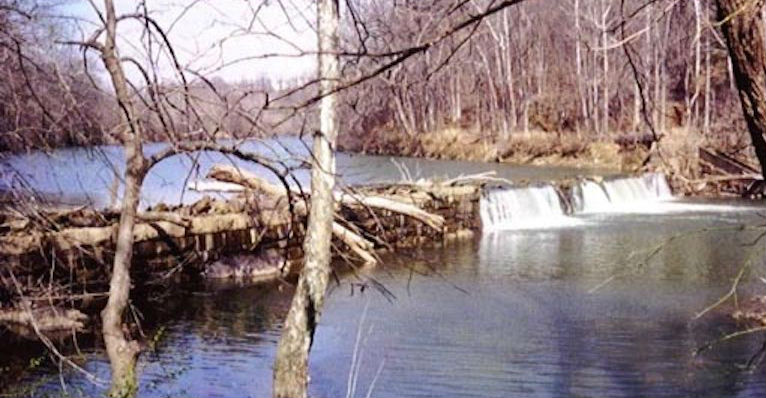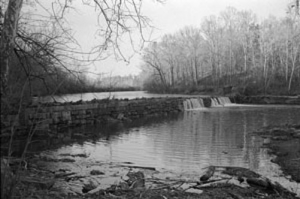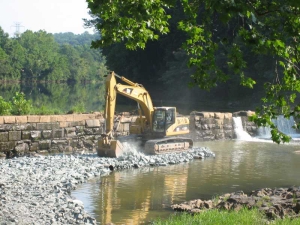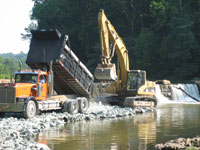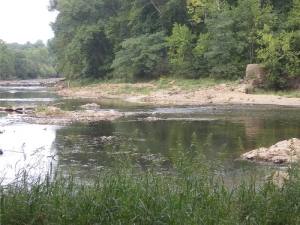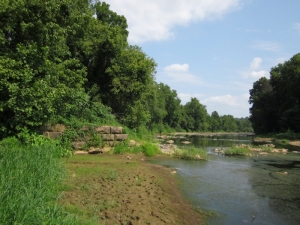Rivanna Conservation Society volunteers created a Restoration Committee that worked for more than 7 years to secure government permits, fiscal support and ultimately contracted for the breaching of the Woolen Mills Dam, which took place on August 15, 2007. The dam breach was made possible by the generous support of the Thach Family, owners of the Woolen Mills Dam. Water quality monitoring continues in order to ascertain the impact of the breach on water quality, aquatic habitat and the American Shad.
View documents related to Woolen Mills here.
History
The dam was built some 178 years ago to provide power to the Woolen Mills. After operating as a power source for a number of years, the mill transitioned to electricity rendering the dam, as a power source, unnecessary. Even so, the structure was picturesque and a familiar landmark, so the dam remained in place nearly 18 decades. In recent times the Woolen Mills Dam has been the property of the Thach family who has owned the dam since the closure of the Woolen Mills back in 1964. So the breaching of the dam, proposed by Rivanna Conservation Society, had to have the blessing and support of the owners.
As civic-minded neighbors, the Thach family has for many years allowed the Rivanna Trail to traverse their private property abutting Moores Creek, below the dam, so the Rivanna Conservation Society was hopeful that the Thach family would approve the breaching of the dam. Having secured the support of the Thach family, the Rivanna Conservation Society contracted for an engineering study in 2003 to ascertain the viability of removing a part of the dam to allow passage of migratory fish such as shad, herring, and American eel. The Rivanna Conservation Society also wanted to assure safe passage for canoeists and other recreational boaters, while making an effort to maintain some of the historical characteristics of the existing dam. No small task, to say the least.
The Process
The Rivanna Conservation Society began the process of raising funds to move from concept to reality. Through the gracious funding support of the Charlottesville Area Community Foundation, Bama Works, Canaan Valley Institute, Virginia Department of Game & Inland Fisheries and American Rivers and the National Oceanic and Atmospheric Administration (NOAA) the feasibility study was undertaken. Contractors were selected through a formal bidding process and Rettew, Inc. of Lancaster, PA evaluated the project’s feasibility and did sediment testing, surveying, and breach design. The Rettew study characterized the hydrology, impoundment, bottom topography of the river, composition of river bottom sediment (the tests for heavy metals and other toxins were negative: nothing found), and predicted the end result of removing 195 of the 270-foot dam. Pressure to remove the dam intensified with the tragic, accidental drowning at the dam in 2004.
Working in concert with Virginia’s Department of Game and Inland Fisheries (DGIF) Fish Passage Coordinator, Alan Weaver, Rivanna Conservation Society hosted a series of meetings with state and federal government agency personnel, followed by community based meetings with the Woolen Mills neighborhood to facilitate the necessary permit process for removing the dam. Seven permits or waivers were needed. The next step was for RCS to submit applications to the US Army Corps of Engineers Nationwide Permits 27 and 33, Virginia Marine Resources Commission permit, Department of Environmental Quality waiver for Clean Water Act permit compliance, Department of Conservation and Recreation Dam Safety permit, and an Albemarle County demolition permit. All permits were approved.
Not surprisingly, given the age of the structure, the dam qualified for listing on the State and National Registers of Historic Sites. This designation required the development of a Memorandum of Agreement (MOA) between Rivanna Conservation Society and the Department of Historic Resources, to assure historic mitigation. Once the permits were submitted and approved by Army Corps of Engineers (ACOE), RCS worked with DGIF, ACOE, and the Department of Historic Resources to draft a MOA outlining each party’s responsibilities during and after deconstruction. This agreement provided for full documentation of the deconstruction process, historic signage and kiosks on both sides of the river (to be completed), donation of representative block and timber samples to the local Albemarle Charlottesville Historical Society and more.
With water quality and aquatic habitat in mind, the Rivanna Conservation Society, in cooperation with the US Fish & Wildlife Service’s State Fisheries Coordinator Albert Spells, contracted with the University of Virginia to document fish population through a monitoring study conducted before and after dam removal.
After a formal bidding process, the Rivanna Conservation Society awarded the demolition contract to the lowest bidder: Shelbeck Excavation of Scottsville, VA. Isaac Shelley and his crew (JJ, Thomas, and Billy) took advantage of the low water caused by the summer drought and in early August built a ramp and causeway from the private driveway of Security Storage Allied Van Lines at the end of E. Market Street. This causeway went down into the river and allowed for the transport of the heavy equipment necessary to complete the demolition. Rivanna Conservation Society Committee members, including engineer Pat Punch, were on site almost every day to monitor and guide the work. The Shelbeck track hoe operator (JJ) did an outstanding job of removing the blocks of cut stone, one by one. This careful process ensured the gradual release of the impounded water. With precision, each course of block was removed, allowing water to spill over the lowered dam, causing the impoundment behind the dam to fall, foot by foot.
Aided by the mostly dry weather, the entire Woolen Mills Dam deconstruction took less than 3 weeks. The demolition process was extensively documented by a historical resources consultant from Gray & Pape, Inc. The process was also documented by Rivanna Conservation Society members, area homeowners and the local press. A small community of onlookers gathered each day at the site to watch and talk about the historic process. Personal stories were shared: memories of fishing, swimming and playing in the waters above and below the dam.
The Shelbeck team was moving to completion and using the engineering plans developed by Rettew, Inc. removed approximately 195 out of 270 feet of the structure, leaving short sections of block on both sides of the river for historic interpretation. Stone supports for wooden gates of the old sluiceway that carried water to the mills, will remain on the Market Street side. On the other side of the river, the old lock and a non-functioning fish ladder also remain– both of which can be easily accessed by the newly created Old Mills Trail. The dam materials – 12 inch by 12 inch timbers fastened together by iron spikes and the hand-hewn stone blocks, were returned to the Thach family who still own the remaining structure. A representative piece of the wood structure, one full stone block, photos and historical documentation will be delivered to the Albemarle Charlottesville Historical Society for their collection.
As the water level behind the dam dropped over the course of several days, the structure and shape of the river bottom began to emerge, revealing dying and decaying algae (algae growth is bad and is the result of the stagnant, oxygen-depleted water behind the dam). Behind the rock face of the dam, the timber cribbing appeared. The breach revealed a short section of another impounding structure—perhaps a coffer dam used to divert water for work on the main dam.
The Result
The Rivanna River, through this section of Charlottesville, is now a very different river, returning to a natural state, much like it was before the structure was built in the early 1800’s. In those days, the entire length of the Rivanna, from the Port of Pireus to Columbia, contained a series of flat-water impoundments behind dams, used to harness water power for mills and to fill locks for transport of goods and people. The only remaining structures now on the Rivanna main stem are the dam that created the South Fork Rivanna Reservoir, impounded for our urban drinking water supply, and small dams on the North Fork at Camelot (also for drinking water) and Advance Mills (no apparent use).
The beautiful rock garden now revealed at Riverview Park will be a kayaker’s haven once the rains return and the river level rises again. Once the water is up, the peaceful sounds of the rippling rapids return to Riverview Park, a sound that hasn’t been heard there for 178 years. As the shad and eels begin to migrate upstream, the community will witness the events as nature intended and as they have unfolded for countless centuries before the intervention of man.
To help ensure that the shad and other aquatic life return to upstream Rivanna, the Rivanna Conservation Alliance and the Department of Game & Inland Fisheries are committed to stocking shad fry at Darden Towe Park. As has been the case the past three years, elementary school children come to help release the shad fry. The intention is to educate the community and its students while providing a future fish stock for the Rivanna. Neighborhood anglers are excited about the potential for improved fishing on the Rivanna and canoeing the river will be much easier and a lot more fun.
This project could never have come to fruition without the support and generosity of its members (and non-members) who gave of their time and money to make this project a reality. Without the dedication of committee volunteers, the Rivanna Conservation Alliance Board and staff, and the donations of Society members, foundations and government agencies, this dam breach project would not have been possible. Thank you one and all! We’ll see you on the river!
Thank you to the Rivanna Conservation Society Boards of Directors and to the Rivanna River Restoration Committee for their support of and dedication to this important project.
And, without the donations and contribution of our major supporters, the Woolen Mills Dam Breach could never have been accomplished. Rivanna Conservation Alliance extends its most sincere appreciation to:
American Rivers
Anonymous Local Foundation
Bama Works Fund (The Dave Matthews Band)
Charlottesville Area Community Foundation
I.J. & Hilda M. Breeden Foundation
Canaan Valley Institute
Chesapeake Bay Program of U.S. EPA
FishAmerica Foundation
National Oceanic & Atmospheric Administration
The Hartfield Foundation
The Perry Foundation
US Fish and Wildlife Service
Virginia Department of Game & Inland Fisheries
Wal Mart
WestWind Foundation
Rivanna River Restoration Committee Volunteers
Dr. Marty Albert
Pat Calvert
Eric Gilchrist
Jason Halbert, Chair
David Hannah
Hank Helmen
Michele Mattioli
Angus Murdoch
Leslie Middleton
Pat Punch
Tim SanJule
Erik Wilke
Ceremony Coordination
Robbi Savage, Executive Director
Mary Anderson, Administrative Assistant
Sara Becker, Student Intern Corps
Jackson Means, Student Intern Corps
Stefanie Zaenker, Student Intern Corps

